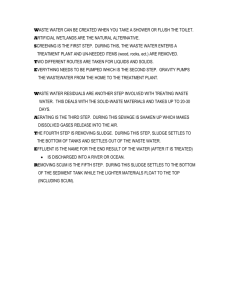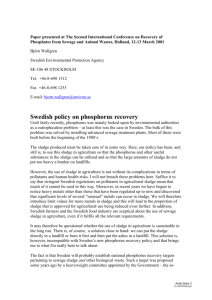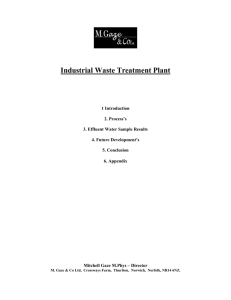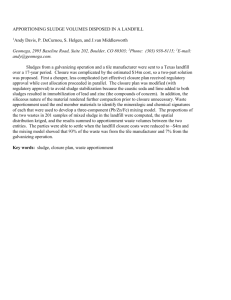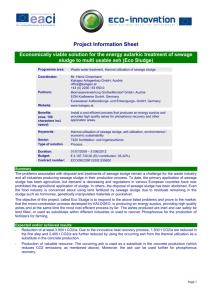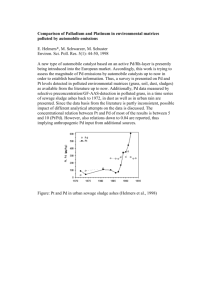Abstract
advertisement
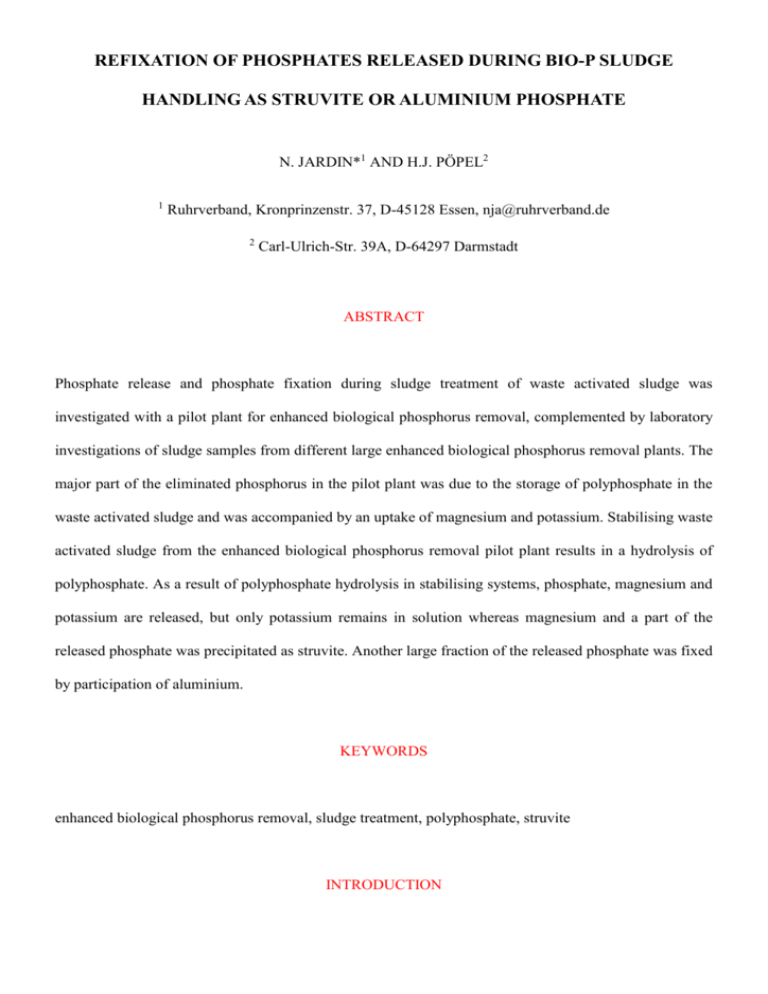
REFIXATION OF PHOSPHATES RELEASED DURING BIO-P SLUDGE HANDLING AS STRUVITE OR ALUMINIUM PHOSPHATE N. JARDIN*1 AND H.J. PÖPEL2 1 Ruhrverband, Kronprinzenstr. 37, D-45128 Essen, nja@ruhrverband.de 2 Carl-Ulrich-Str. 39A, D-64297 Darmstadt ABSTRACT Phosphate release and phosphate fixation during sludge treatment of waste activated sludge was investigated with a pilot plant for enhanced biological phosphorus removal, complemented by laboratory investigations of sludge samples from different large enhanced biological phosphorus removal plants. The major part of the eliminated phosphorus in the pilot plant was due to the storage of polyphosphate in the waste activated sludge and was accompanied by an uptake of magnesium and potassium. Stabilising waste activated sludge from the enhanced biological phosphorus removal pilot plant results in a hydrolysis of polyphosphate. As a result of polyphosphate hydrolysis in stabilising systems, phosphate, magnesium and potassium are released, but only potassium remains in solution whereas magnesium and a part of the released phosphate was precipitated as struvite. Another large fraction of the released phosphate was fixed by participation of aluminium. KEYWORDS enhanced biological phosphorus removal, sludge treatment, polyphosphate, struvite INTRODUCTION Most of the new or expanded wastewater treatment plants in Germany are designed for the so called enhanced biological phosphorus removal process (EBPR). In contrast to conventional plants, the phosphorus content of the activated sludge solids from this process reaches values of up to 7 %. Phosphorus can be bound in the activated sludge mainly by three mechanisms: One is as physiological phosphorus, that is, P for metabolism and growth as nucleic acids (DNA, RNA), phospholipids and nucleotides (NAD, FAD). Second, in plants with EBPR, additional phosphorus can be stored as polyphosphate (poly-P), Men+2PnO3n+1 (n indicates the chain length of poly-P and Me represents a metal cation). Usually, magnesium (Mg) and potassium (K) are associated with poly-P synthesis. Finally, a physicochemical fixation of phosphate mainly by precipitation or adsorption can occur. During sludge treatment, these P-fractions will be released to a different extent and at different rates. Therefore, investigations concerning the rate and amount of P-release and possible P-fixation mechanisms during sludge treatment have to consider type and extent of these different P-fractions in waste activated sludge (WAS). From a theoretical point of view, most of the phosphorus eliminated in form of poly-P should be released during the anaerobic treatment of WAS [9]. In contrast, at most large plants in Germany the soluble phosphorus concentration of digested sludge is often very low [12, 2] whereas from other plants additional phosphorus loads of up to 100 % are reported [8, 11, 7]. Therefore, conditions have to be exist where only a part of the stored phosphorus is released to the bulk liquid of the sludge treatment system or some of the released phosphorus is chemically fixed as metal phosphate precipitates or by other mechanisms. In order to pursue the fate of the total phosphorus during wastewater and sludge treatment, an EBPR pilot plant with different sludge treatment systems has been operated over a 2 year period. Some of the results obtained during this study will be presented in the following with special respect to (i) the determination of type and extent of phosphate fixation in WAS, (ii) the estimation of the amount of P-release and the resulting P-feedback during sludge stabilisation, and (iii) the investigation of physico-chemical P-fixation mechanisms in stabilising systems. MATERIALS AND METHODS The pilot plant (PP) consisted of two continuous flow activated sludge systems both operated with settled domestic sewage (Figure 1). Plant 2 has been operated with an anaerobic zone for EBPR, whereas plant 1 served as a control without an anaerobic tank. The WAS of the EBPR plant was withdrawn directly from the activated sludge tank to prevent anaerobic conditions prior to sludge treatment. Thickening of the sludge was carried out with a centrifuge, a flotation unit or by gravity thickening. Thereafter, the thickened sludge was mixed with primary sludge and pumped into the stabilising system that consisted of an anaerobic-mesophilic digester (AMS) and aerobic-thermophilic stabilisation (ATS). The stabilising reactors were operated in parallel at different retention times (AMS: 15 to 30 days; ATS: 3 to 12 days), temperatures (AMS: 35°C; ATS: 50 to 65°C) and solid concentrations (1 to 5 % total solids (TS). The design parameters and the average operating conditions of the EBPR and conventional pilot plant in the first experimental year are shown in Tables 1 and 2, respectively. Because of the very low phosphorus content of the domestic sewage used for the experiments, the inflow of the pilot plant was supplemented with phosphoric acid, and in some experimental phases, with acetic acid to improve EBPR. For the investigation of physicochemical P-fixation mechanisms sludge samples from different large and pilot EBPR and conventional plants were used. The characteristics of these sludges are summarised in Table 3. To investigate the pH-dependent release of phosphate an acidimetric titration was performed. For this purpose, a 1-l sludge sample was titrated with concentrated HCl. Once a desired pH was achieved, 40 ml of sludge was withdrawn and incubated for 24 h to establish equilibrium. Usually, the acidimetric titration cover a pH range from original pH to a pH of 1. After the incubation period, the pH was measured again and the samples were centrifuged at 30,000g for 10 minutes followed by 0.45-m filtration. In the filtrate PO4-P and the major cations were analysed. All sludges were examined further with a sequential dilution test. Because of the successive reduction of total solids concentration in the course of the dilution procedure, the solubility behaviour of precipitated solids can be selectively modified without changing pH. For this test, 50 ml of sludge was filled in a 100-ml volumetric flask. Deionised water (A. dest) was added to make up 100 ml and subsequently, the dilution was vigorously shaken for 2 minutes. From this dilution step another 50 ml were transferred to the next 100-ml flask, and the dilution procedure was repeated as described until a final dilution of 1 to 1024 was reached. After an equilibration period of 24 hours the samples were centrifuged, filtrated and analysed for phosphorus and cations. P-fractionations were used to differentiate between the phosphorus fixation mechanisms. For this purpose a modified method of Psenner et al. [10] and Uhlmann et al. [13] was used. The fractionation consists of sequential extractions of the sludge samples with different extracting chemicals followed by incubation, centrifugation and analysis of the supernatant. In the supernatant PO4-P (after 0.45-m filtration) and Ptot were determined. PO4-P concentration represents the so-called dissolved reactive phosphate (DRP) and the difference between Ptot and PO4-P is called the nonreactive phosphate (NRP). Elementary analyses of P, Ca, Mg, K, Al and Fe in the sludge samples were performed by means of atomic absorption spectrometry (AAS) with a Perkin Elmer 2100. Soluble Ca2+, Mg2+, K+ and Na+ were analysed by ion chromatography with a Dionex ISP 2000. Al3+ was determined by a colorimetric method using chromazurol S. X-ray diffraction analysis were performed using a STOE powder diffraction system. For energy dispersive X-ray spectroscopy a Joel JSM 35 scanning microscope and a Tracor 5500 were used. With this system the element distribution of the samples could be visualised for a total of 8 elements at the same time. All other analyses were performed according to DEV [3]. RESULTS AND DISCUSSION Type and mechanisms of P-binding in WAS During the 2-year experimental period, the P, Mg, K, Ca, Fe and Al contents of the WAS from the EBPR plant were determined weekly. From a correlation analysis, it was found that magnesium and potassium were significantly correlated on an = 0.01 level with phosphorus. This indicates that poly-P formation, which usually is accompanied by an uptake of these cations, has taken place. The linear regression between the cations and the phosphorus content of the WAS is sketched in Figure 2. From this graph a molar uptake ratio of 0.335 M Mg M-1 P and 0.258 M K M-1 P can be calculated which agrees well with values reported in the literature (e.g. [14, 1]). No correlation between P and Ca, Fe or Al was found. Consequently, the amount of physicochemically fixed phosphorus in the WAS of the EBPR plant was very low under the operating conditions used in this study. Although these dependencies provided a strong indication that at least part of the phosphorus is fixed as poly-P, it was not possible to calculate the exact amount of poly-P storage. To quantify the amount of poly-P, P-fractionations were used. Figure 3 shows the results of the periodically performed fractionations of the WAS from the EBPR plant. As it can be seen from this figure, the major part of total phosphorus is recovered as NaOH-NRP. In WAS from plants with EBPR, this fraction usually consists of organic phosphorus and poly-P, whereas at plants with iron or aluminium precipitation the major part of precipitated phosphorus is also found in this fraction. A differentiation between the different P-species is facilitated if the counterions are considered. Potassium gives especially valuable indications toward P-binding in the NaOH-fraction. Because of the former uptake in the course of poly-P synthesis, potassium is expected to be released simultaneously with poly-P during the alkaline extraction. Because potassium usually participates only to a small degree in precipitation or adsorption reactions in wastewater and sludge treatment, it can be assumed that high potassium levels in the extracts are mainly the result of poly-P hydrolysis. Therefore, we looked for a dependence between potassium and NRP/DRP concentrations in the different extracts. For the NaOH-NRP fraction, this dependence is also depicted in Figure 3. From this graph it can be seen that NaOH-NRP and potassium are very closely correlated. This clearly demonstrates that for the WAS from the pilot plant, the major part of phosphorus in the NaOH-NRP fraction can be assigned to poly-P. Furthermore, for the other fractions, a similar correlation between DRP and potassium was found (data not shown). In all, a poly-P content of 50 to 70 % of total P could be calculated assuming an exchange ratio between phosphorus and potassium of 0.34 M K M-1 P. P-release and P-fixation during sludge stabilisation Because of the elevated temperatures in anaerobic-mesophilic (T = 35°C) or aerobic-thermophilic (T = 50 to 60°C) stabilisation, it could be expected that complete poly-P hydrolysis occurs within a fraction of the usual retention time of these stabilising systems. Using P-release kinetics [6] it can be estimated that 90 % of the poly-P is hydrolysed within 1.5 days at 35°C and within 7 hours at 60°C. Beside this theoretical calculation, further evidence for a complete release of the stored poly-P in our experiments was provided by P-fractionations and potassium balances. Figure 4 summarises P-fractionations of both anaerobic-mesophilic and aerobic-thermophilic stabilised sludge. Clearly, the NaOH-NRP fraction that comprises the major part of poly-P was reduced to below 4 % (ATS) and 6 % (AMS) of total P. Considering that organic phosphorus will also be found in this fraction, the poly-P content of the sludge samples tends to be zero. From these fractionations it is obvious that a shift from the NaOH-NRP fraction in WAS towards the NaOH-, HCl- and to a lesser extent to the original-DRP fraction has occurred. The former two fractions mainly consist of physicochemically fixed phosphorus, whereas the latter fraction represents the soluble phosphate in the stabilising system. The same result, that is, a complete release of poly-P, was obtained performing potassium balances for the stabilising systems [5], assuming that potassium is released during poly-P hydrolysis and does not participate in precipitation reactions and remains, therefore, in soluble form. Although these experiments provide evidence that stabilising WAS from EBPR plants with AMS or ATS causes a rapid hydrolysis of poly-P, only a part of the released phosphate remains in solution. In our experiments the amount of soluble PO4-P depended mainly on the total P-concentration in the stabilising system, which primarily reflects the amount of poly-P in the inflow to AMS or ATS. At total P concentrations in the stabilising system of 1,000 to 1,500 mg l-1 Ptot, which is common for large wastewater treatment plants, the amount of soluble phosphate accounts for not more than 20 % of Ptot, whereas at excellent EBPR conditions with a total P concentration of up to 4,000 mg l-1, the amount of PO4-P increased to 38 % of Ptot. From the results obtained so far it seems clear that the difference between released phosphorus and the soluble phosphorus concentration observed during stabilisation was mainly fixed by physicochemical mechanisms. To estimate the amount of physicochemical phosphorus fixation, some of the possible counterions for precipitation and/or adsorption reactions were examined further. In view of their high amounts in stabilised sludge, aluminium, magnesium, and calcium should be the most likely counterions for physicochemical fixation of phosphorus. Beside the sludges from the pilot plant, different stabilised sludge samples from large wastewater treatment plants with or without EBPR, which are described in detail in Materials and Methods, were also included in the investigations. They were examined towards possible interactions of magnesium, aluminium and calcium with phosphate. Magnesium is affected by sludge stabilisation in two ways: First, because of the degradation of organic material a part of the physiological magnesium is dissolved, and second, magnesium is released in the course of poly-P hydrolysis. In view of the high ammonium concentrations in stabilising systems, a precipitation of magnesium in the form of MgNH4PO4 6 H2O (struvite) seems to be the most likely reaction to occur. In fact, struvite was found in most of the sludge samples as was demonstrated by X-ray powder diffractometry and energy dispersive X-ray spectroscopy (EDXS). This is shown in Figure 5 for a digested sludge sample from the EBPR pilot plant. The diffraction pattern (A) of the sludge agrees well with the theoretically expected pattern for struvite and, furthermore, EDXS shows (B) that phosphorus and magnesium are closely correlated in the sample. Furthermore, all sludge samples were examined by a sequential dilution procedure in which dissolution of precipitated solid phases is achieved through progressive dilution of the sludge sample. The results of these tests are summarised in Figure 6 by correlating the amount of released magnesium with the released phosphate in the course of the sequential dilution. For the EBPR sludges a surprisingly high correlation between phosphate and magnesium release was found. To verify that the observed release behaviour was mainly due to the dissolution of struvite, digested sludge from the pilot plant, which was supplemented with phosphate and magnesium to induce struvite precipitation (struvite formation was proved by X-ray diffraction), was also investigated with the sequential dilution test. A comparison with the EBPR sludges reveals a nearly identical release behaviour which provides further evidence that the released amounts of magnesium and phosphate in the EBPR sludge samples are due to the dissolution of struvite solids. From the sequential dilution test the amount of struvite in the original sample could easily be determined using the total phosphate and magnesium release during the dilution procedure. The amount of P-fixation in form of struvite was highest in the EBPR sample from the pilot plant (37 % of Ptot) and was usually in the range of 20 to 30 % of Ptot [4] Greater deviations from the predicted release behaviour were only found in the sludge samples from the plant with simultaneous precipitation, which is obviously due to a dissolution of iron phosphate. Because of the substitution of detergent phosphates with zeolites in Germany (e.g. zeolite A: Na12(AlO2)12(SiO2)12 · 27 H2O), sludges from wastewater treatment plants usually show relatively high aluminium concentrations (in the sludge samples: 17 to 35 mg Al g-1 TS). Therefore, aluminium was also considered as a possible counterion for phosphate precipitation or adsorption in stabilised sludge. Although in none of the sludges indications for crystalline aluminium solids were found, acidimetric titration of the sludge samples reveals a significant participation of aluminium in phosphate fixation as is shown in Figure 7. Below pH 3 to pH 3.5, the release behaviour of both aluminium and phosphate is very similar, whereas greater differences for the phosphate release exist at higher pH values which are mainly due to the release of other solid phases (e.g. struvite). For the EBPR sludges from plants with the main stream process, the amount of P fixed by interaction with aluminium, was calculated as 35 to 52 % of Ptot. Although the exact mechanisms of phosphate-aluminium interactions are not clear yet, we believe that phosphate is mainly fixed by surface reactions, such as complexation or adsorption to aluminium solids. Calcium was also considered as one of the possible counterions for phosphate fixation in stabilising systems and was, therefore, further examined. Just as with aluminium, no crystalline calcium phases were found in any of the sludges. Because most of the possible calcium-phosphate precipitates are acid-labile, acidimetric titration was used to determine the amount of possible calcium-phosphate fixation. In Figure 8 the release of calcium is normalised to the total calcium content of the sludge samples. Some interesting information concerning possible interactions between calcium and phosphate could be obtained from this graph. First, although there are quite great differences in the total calcium concentrations in the sludge samples, only minor differences are found in the release behaviour normalised to the total concentration. Furthermore, the behaviour of the different sludges (e.g. primary sludge, EBPR sludge and digested sludge supplemented with phosphate and magnesium) is nearly the same. Second, a correlation between the release of phosphate and calcium was not found in any of the titrations (data not shown). Therefore, it seems likely that calcium did not participate in phosphate fixation reactions and was mainly bound by other mechanisms in the sludge samples, such as adsorption to hydroxyl surfaces. In cases of high P-concentrations in sludge water, precipitation of phosphate in the centrate or filtrate of the dewatering facility can be necessary. In principle, all common chemicals for phosphate precipitation could be used but in view of the relatively high ammonium concentrations and the high alkalinity of the process water, precipitation with calcium can require large amounts of lime. Using iron, the reduction of Fe3+ to Fe2+ has to be considered. Figure 9 shows the results of PO4 precipitation in sludge water using different chemicals and different initial phosphate concentrations. As can be seen from these figures, aluminium proved to be most effective on a molar base. Usually, more than 80 % of the soluble phosphate was precipitated at a molar dosage of 1 M Al M-1 P, whereas for calcium and iron an 80 % elimination was achieved only when a molar dosage of 2 M Ca M-1 P or 1.5 M Fe M-1 P was reached. CONCLUSIONS Under the conditions of this study 50 to 70 % of total phosphorus in WAS of the EBPR pilot plant was stored as poly-P which could be calculated on the basis of P-fractionations and potassium balances. Poly-P synthesis was always accompanied by an uptake of magnesium and potassium at a molar ratio of 0.34 M Mg M-1 P and 0.26 M K M-1 P, respectively. Poly-P hydrolysis during stabilising WAS was complete within the retention time of the stabilising systems which could be demonstrated by P-fractionations and potassium balances. However, because of physicochemical fixation mechanisms only a part of the released phosphate remains in solution. In the P-fractionation a shift from the NaOH-NRP fraction of the WAS (primarily poly-P) toward the NaOHand HCl-DRP fractions (primarily physicochemical P-fixation) in stabilised sludge was observed. The amount of soluble phosphate in the stabilising system depends mainly on poly-P content in the WAS. From the results obtained in our study, the P-feedback on the average large EBPR plant, characterised by a total P content of not more than 35 mg P g-1 TS in the WAS, was estimated to be below 20 % of the influent P load. In the stabilising system the released phosphate was fixed mainly by two mechanisms: First, because of the simultaneous release of magnesium during poly-P hydrolysis, a part of the released phosphate was precipitated as struvite. Second, another fraction of released phosphate was fixed by interactions with aluminium, probably by surface reactions on aluminium solids. No participation of calcium in phosphate fixation reactions was found. To prevent a possible P-feedback in cases of high phosphate concentrations in the sludge water of a dewatering system, precipitation with lime, iron or aluminium could be necessary. From our experiments aluminium-phosphate precipitation seemed to be most effective. ACKNOWLEDGEMENTS The financial support for this study was provided by the German Minister for Research and Technology (BMFT), grant No. 02 WS 8922/2. REFERENCES [1] Arvin, E.; Kristensen, G.H. (1985) Exchange of organics, phosphate and cations between sludge and water in biological phosphorus and nitrogen removal process. Water Science and Technology, 17, 147-162. [2] Baumann, P., Krauth, Kh. (1991) Untersuchung der biologischen Phosphatelimination bei gleichzeitiger Stickstoffelimination auf der Kläranlage Waiblingen. Korrespondenz Abwasser, 38, 191-198. [3] DEV (1960) Deutsche Einheitsverfahren zur Wasser-, Abwasser- und Schlammuntersuchung.VCH Verlagsgesellschaft, Weinheim. [4] Jardin, N.; Pöpel, H.J. (1994a) Physico-chemical fixation of phosphate in sludges from enhanced biological phosphorus removal during stabilisation. In.: 6th International Gothenburg Symposium on Chemical Treatment III, Springer Verlag, Berlin, Heidelberg, New York, 353-372. [5] Jardin, N.; Pöpel, H.J. (1994b) Phosphate release of sludges from enhanced biological P-removal during digestion. Water Science and Technology, 30, 281-292. [6] Jardin, N.; Pöpel, H.J. (1994b) Behavior of waste activated sludge from enhanced biological phosphorus removal during sludge treatment. Water Environment Research, 68, 965-973. [7] Murakami, T.; Koike, S.; Taniguchi, N.; Esumi, H. (1987). Influence of return flow phosphorus load on performance of the biological phosphorus removal process. In: Biological phosphate removal from wastewaters. R. Ramadori (Ed.). Pergamon Press, Oxford, 237-247. [8] Pitman, A.R., Deacon, S.L., Alexander, W.V. (1991) The thickening and treatment of sewage sludges to minimize phosphorus release. Water Research, 25, 1285-1294. [9] Pöpel, H.J.; Jardin, N. (1993) Influence of enhanced biological phosphorus removal on sludge treatment. Water Science and Technology, 28, 263-271. [10] Psenner, R.; Pucsko, R.; Sager, M. (1984) Die Fraktionierung organischer und anorganischer Phosphorverbindungen von Sedimenten. Arch. Hydrobiol./Suppl., 70, 111-155. [11] Sen, D.; Randall, C.W. (1988) Factors controlling the recycle of phosphorus from anaerobic digesters sequencing biological phosphorus removal systems. Hazard. Ind. Waste, 20, 286-298. [12] Seyfried, C.F.; Hartwig, P. (1991) Großtechnische Betriebserfahrungen mit der biologischen Phosphorelimination in den Klärwerken Hildesheim und Husum. Korrespondenz Abwasser, 38, 185-191. [13] Uhlmann, D.; Röske, I.; Hupfer, M.; Ohms, G. (1990) A simple method to distinguish between polyphosphate and other phosphate fractions in activated sludge, Water Research, 24, 1355-1360. [14] Wentzel, M.C.; Ekama, G.A.; Marais, G.v.R. (1992) Processes and modelling of nitrification denitrification biological excess phosphorus removal systems - a Review. Water Science and Technology, 25, 59-82. PP I conv. aerobic influent excess sludge PP II EBPR (A/O) phosphoric acetic acid acid an. aerobic centrifuge, flotation or gravity thickener primary sludge dewatering excess sludge sludge water dewatering anaerobic-mesophilic stabilisation (AMS) (1,5 m3) aerobic-thermophilic stabilisation (ATS) (1,5 m3) parameter plant 1 plant 2 3 volume (m ) 10 16 3 influent flow (m h 2.5 4 1 ) aerobic HRT1 (h) 4 2.5 1 anaerobic HRT (h) 1.5 MCRT (d) 2.6 2.6 1 hydraulic retention time based on influent flow rate parameter BOD5 (mg l-1) COD (mg l-1) Ptot (mg l-1) TKN (mg l-1) NH4-N (mg l-1) influent 175 340 12.4 66 48 plant 1 effluent 20 82 10.3 23 19 plant 2 effluent 14 62 3.3 23 21 sludge name (abbreviation) DS EBPR MS origin Digester sludge from a large EBPR plant with main stream process (PHOREDOX) stab. ES EBPR MS Stabilised sludge from a large EBPR plant with main stream process (ISAH) DS EBPR MS PP Digester sludge from the EBPR pilot plant with main stream process (A/O) DS EBPR SS Digester sludge from a large EBPR plant with side stream process (PHOSTRIP) DS Sim Digester sludge from a large plant with simultaneous precipitation (Fe) PS Primary sludge a) b) TS = Total solids, VS = Volatile solids TSa) [g l-1] VS b) [%] pH 38.6 51.4 29.8 7.32 P [mg g1 ] 27 Ca [mg g1 ] 51.5 Mg [mg g1 ] 9.8 K [mg g1 ] 7.4 Al [mg g1 ] 17.1 Fe [mg g1 ] 15.2 59.6 6.82 42.8 40.6 10 13 35 11.6 28.8 58.4 7.29 52.2 45.2 11.2 16.9 23.8 10.5 25.9 55.8 7.46 26.8 57.8 7.7 6.8 26.3 12 49.3 51.5 7.8 27.2 85.4 5.8 2 17 49.7 40.6 75.5 5.46 10 31.6 3.6 5.6 17.2 10.2 Mg, K [mg g -1 TS] 24 22 20 18 16 14 12 10 8 6 4 2 0 K 0.325 mg K P mg P Mg mg Mg 0,259 P mg P 15 20 25 30 35 40 45 Ptot [mg P g -1 TS] 50 Mg K 55 60 65 45 40 [%] of P tot 35 30 25 NaOH-K [mg K g -1 TS] 50 DRP NRP 12 10 K = 0.34 * P + 3.54 8 6 12 14 16 18 20 22 24 NaOH-NRP [mg P g -1 TS] 20 15 10 5 0 Original A.dest BD NaOH HCl 50 AMS ATS 45 40 [%] of Ptot 35 30 25 20 15 10 5 0 DRP NRP DRP NRP DRP NRP DRP NRP DRP NRP Original A.dest. BD NaOH HCl A B 50 micron MG P 35 DS EBPR MS stab. ES EBPR MS DS EBPR MS PP DS EBPR SS DS Sim DS EBPR MS PP 1) 30 Mgreleased [mM] 25 regression for DS EBPR MS PP 1) Mg [mM] = 0.94 PO4-P [mM] - 0.33 r2 = 0.992 20 15 10 regression for all EBPR sludges Mg [mM] = 0.95PO4-P [mM] - 0.1 r2 = 0.985 (solid line) 5 0 0 5 10 15 20 Preleased [mM] 25 30 35 1 1 aluminium DS EBPR MS stab. ES EBPR MS DS EBPR MS PP DS EBPR SS DS Sim PS phosphate DS EBPR MS stab. ES EBPR MS DS EBPR MS PP DS EBPR SS DS Sim PS 0.8 0.6 0.4 0.6 0.4 aluminium release 0.2 0.2 0 0 0 1 2 3 4 pH 5 6 7 8 PO 4-P (Ptot)-1 Al3+ (Altot)-1 phosphate release 0.8 1 0.9 0.8 Ca2+ (Catot)-1 0.7 0.6 0.5 0.4 DS EBPR MS stab. ES EBPR MS DS EBPR MS PP DS EBPR MS PP DS EBPR SS DS Sim PS DS EBPR MS PP supplemented with P and Mg 0.3 0.2 0.1 0 0 1 2 3 4 pH 5 6 7 8 PO4-elimination [%] 100 90 80 70 60 50 40 30 20 10 0 Ca(OH)2 (1.7 g l-1) 0 0.5 1 1.5 2 2.5 3 3.5 Ca P-1 [M M -1] 100 90 80 70 60 50 40 30 20 10 0 4 4.5 5 PO4-elimination [%] FeCl3 · 6 H2O (5 g l-1) 0 0.5 1 PO4-elimination [%] 100 90 80 70 60 50 40 30 20 10 0 1.5 2 2.5 3 3.5 Fe P-1 [M M -1] 4 4.5 5 Al2(SO4)3 · 18 H2O (10 g l-1) 0 1 2 3 Al P-1 [M M -1] 4 5 Figure 1: Flow diagram of the pilot plant Figure 2: Dependence between phosphorus and magnesium/potassium content in WAS Figure 3: P-fractionation of WAS (bars indicate standard error) Figure 4: P-fractionation of anaerobic-mesophilic and aerobic-thermophilic stabilised sludges (bars indicate standard error) Figure 5: X-ray diffraction pattern and distribution diagram of phosphorus and magnesium for a digested sludge sample from the EBPR pilot plant (A: X-ray diffraction pattern; B: distribution of P and Mg from EDXS) Figure 6: Phosphate and magnesium release during the sequential dilution test Figure 7: Al3+ and PO4-P release in the course of acidimetric titration Figure 8: Course of calcium release in the acidimetric titration Figure 9: Summary of PO4 precipitation experiments in sludge water using different chemicals Table 1: Design parameters of the pilot plants (mean values during the first experimental year) Table 2: Average operating conditions of the pilot plants (mean values during the first experimental year) Table 3: Characterisation of the sludges used for the investigations of physico-chemical P-fixation mechanisms
